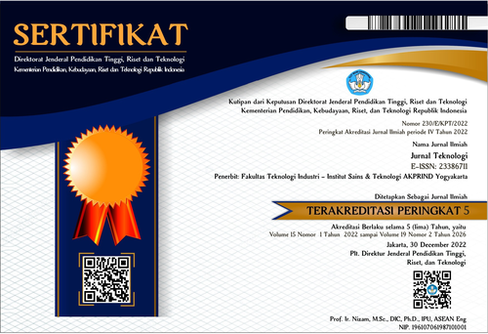Analisis Perancangan Mesin Pencacah Limbah Plastik Menggunakan Pisau Crusher dan Shredder
DOI:
https://doi.org/10.34151/jurtek.v16i1.3895Keywords:
crusher, Finite Element Analysis, plastic wast, shredderAbstract
Waste in the form of garbage in the Piyungan area, Bantul Regency, consists of organic and non-organic waste, currently the condition is increasingly worrying because the landfills are very limited, so waste management must be managed optimally. To reduce the accumulation of excessive waste, a waste-cutting machine is needed. An efficient waste-cutting machine requires the right knife by choosing a knife between the crusher and shredder types. The selection of one of the blades used in the waste-cutting machine requires a design analysis using FEA (Finite Element Analysis) calculations and simulation assistance. Based on the results of the analysis of the calculation of the crusher-type knife using 4 blades, the required power is 2 HP, costs 8.8 million rupiahs and, the results of the FEA allowable stress test are 3.19E + 04, and 2.5 E + 08 are safe. While the Shredder type blade uses 13 blades, the required power is 2 HP, which costs 9.8 million rupiah and the FEA allowable stress test results are 1.53E+04 and 2.5E+08 safe. The results of the analysis obtained are that the selected crusher-type knife can be recommended for use in the design of a waste chopping machine because the manufacturing cost is 8.8 million and the Allowable stress is 3.19E+04,
Downloads
References
Akhmadi, A. N., & Fajar, M. K. (2019). Rancang Bangun Mesin Shredder Pencacah Sampah Plastik Berbantu Perangkat Lunak Autodesk Inventor 2015. Journal Mechanical Engineering, 8(2), 28–33.
Brunner, I. M. I. M., Norhidayat, A., & Brunner, S. M. (2021). Pengolahan Sampah Organik dan Limbah Biomassa dengan Teknologi Olah Sampah di Sumbernya. VI(3), 2085–2095.
Gunawan, G., Lubis, G. S., & Prima, F. (2022). Analisa Pengaruh Jumlah Mata Pisau Pada Mesin Pencacah Botol Plastik Tipe PET (Polyethylene Terephalate). JTRAIN: Jurnal Teknologi Rekayasa Teknik Mesin, 3(2), 38–43.
Hasibuan, R. (2016). Analisis dampak limbah/sampah rumah tangga terhadap lingkungan hidup. Jurnal Ilmiah Advokasi, 04(01), 42–52.
Lisiak-Myszke, M., Marciniak, D., Bieliński, M., Sobczak, H., Garbacewicz, Ł., & Drogoszewska, B. (2020). Application of finite element analysis in oral and maxillofacial surgery-A literature review. Materials, 13(14), 1–16. https://doi.org/10.3390/ma13143063
Kurowski, P. M. (2022). Finite element analysis for design engineers. SAE International
Priono, H., Ilyas, M. Y., Nugroho, A. R., Setyawan, D., Maulidiyah, L., & Anugrah, R. A. (2019). Desain Pencacah Serabut Kelapa Dengan Penggerak Motor.
Sopyan, D., & Suryadi, D. (2022). Perancangan Mesin Pencacah Plastik Kapasitas 25 Kg. Jurnal Media Teknologi, 6(2), 213–222. https://doi.org/10.25157/jmt.v6i2.2796
Sulistyani, A. T., & Wulandari, Y. (2017). Proses Pemberdayaan Masyarakat Desa Sitimulyo Kecamatan Piyungan Kabupaten Bantul Dalam Pembentukan Kelompok Pengelola Sampah Mandiri (KPSM). Jurnal Pengabdian Kepada Masyarakat (Indonesian Journal of Community Engagement), 2(2), 146. https://doi.org/10.22146/jpkm.27024
Downloads
Published
How to Cite
Issue
Section
License
Copyright (c) 2023 Joko Waluyo

This work is licensed under a Creative Commons Attribution 4.0 International License.
Jurnal Teknologi provides immediate open access to its content in order of making research freely available to the public to support a global exchange of knowledge. All articles published in this journal are free for everyone to read and download, under licence CC BY SA.
Benefits of open access for the author, include:
- Free access for all users worldwide.
- Authors retain copyright to their work.
- Increased visibility and readership.
- No spatial constraints.




















